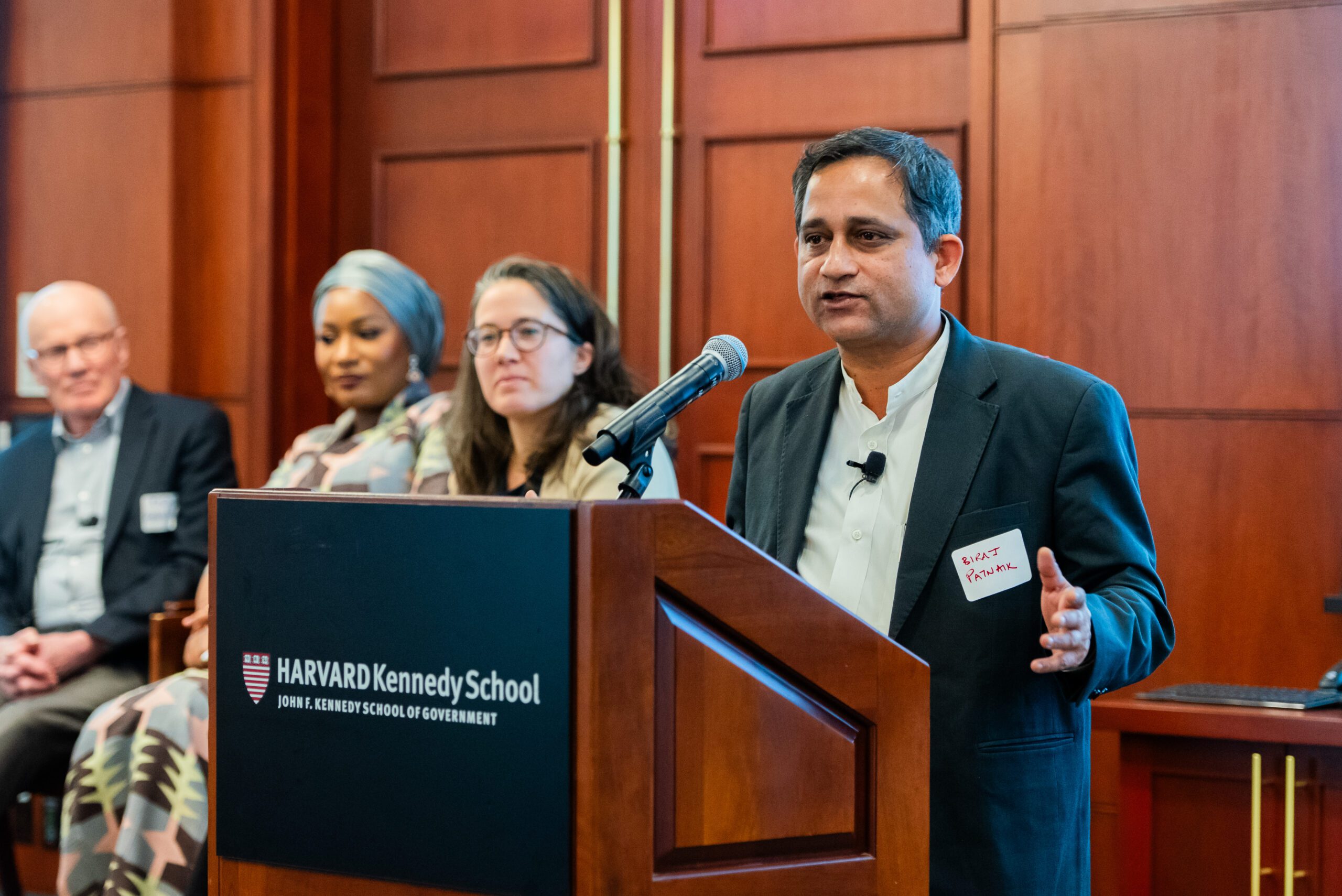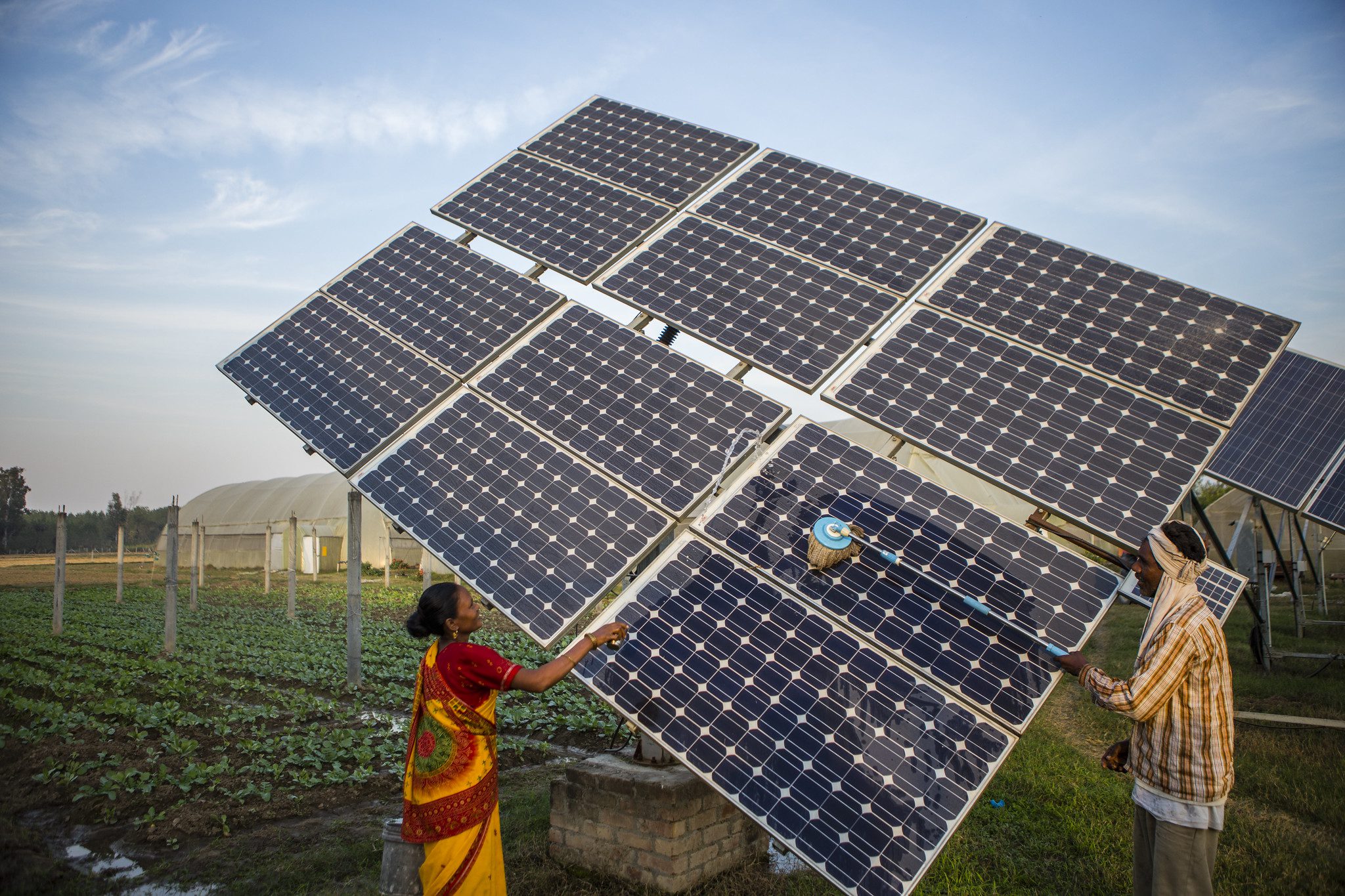
Biraj Patnaik, Executive Director of the National Foundation for India, speaks at the workshop “Adaptation to Climate Change in South Asia and West Africa” at Harvard in November 2023.
In this third installment of a new interview series with Mittal Institute’s Climate Change Platform collaborators in South Asia, we delve into a compelling conversation with Biraj Patnaik, the Executive Director of the National Foundation for India. A human rights practitioner for close to three decades, he is the former South Asia Director of Amnesty International. He was also the Principal Adviser to the Commissioners of the Supreme Court of India on the right to food for over a decade. Patnaik brings a wealth of experience in social justice advocacy, offering unique insights into the intersection of climate change and social inequality. He is also one of the in-region collaborators of the Mittal Institute’s “Climate Adaptation in South Asia” project.
In this interview, Patnaik speaks to the Mittal Institute about the urgent need for a social justice lens in climate action, highlighting the potential risks of leaving vulnerable populations behind in the transition to a greener economy. From mapping the households most affected by climate policies to empowering local communities to engage with government stakeholders, Patnaik offers tangible strategies for addressing these complex issues.
Mittal Institute: Biraj, could you tell us about the work of the National Foundation for India and its focus on social justice issues?
Biraj Patnaik: The National Foundation for India, established in the early 1990s, is India’s pioneering independent domestic philanthropy. Our primary focus is on addressing social justice issues, particularly concerning marginalized communities such as Adivasis, Indigenous peoples, Dalits, and minority groups, including Muslim minorities. We run various programs spanning civil society engagement, climate action, youth empowerment, peace-building initiatives, and media fellowships. However, the focus of everything we do is from the lens of social justice, and within social justice we focus on gender. For example, when we work with civil society organizations on leadership development, we work with women leaders from Adivasi, Dalit, Muslim and other minority communities. So, enabling social justice is what the National Foundation for India is all about.
Mittal Institute: What’s the social justice lens on climate change? And how does the National Foundation for India approach climate action within the framework of social justice?
Biraj Patnaik: The primary question we are trying to explore and work with is: How do you prevent those who will be the worst impacted by climate change from paying a price for mitigation as well?
To put this into perspective, consider the conservation movement in India. When we wanted to reserve forests or create conservation zones exclusively for zoological fauna with no human interference, the people most impacted were those protecting the forest themselves. Indigenous communities – before the colonial experience or when the principle of eminent domain did not apply to these areas – owned the forests as communities and were the worst impacted by the environmental movement.
Now, consider the landless population who uses the commons. If you’re going to have solar panels, for example, as a mitigation strategy, they are most likely going to be installed in the commons. While the government would argue that these commons are not legally owned by people and that they are “wasteland,” not a square inch of land is in fact wasted in India. It is all used either for grazing, foraging, or collecting firewood. Nevertheless, climate mitigation will be used as an excuse to cut these people off from these resources.

Workers clean the solar panels of a solar water pump at a farm in Jagadhri | By Prashanth Vishwanathan.
So, the social justice lens encompasses that if you are already vulnerable, the price you pay for climate mitigation will be far greater than if you were from a less vulnerable community. And yet in adaptation and mitigation strategies, this is often not factored. So how do we work with governments to ensure that the most vulnerable, especially informal workers and the landless population, don’t get left behind? That’s the challenge the National Foundation for India is trying to address because there aren’t too many civil society organizations that bring the social justice lens to climate problems in India – at least not yet.
The social justice lens encompasses that if you are already vulnerable, the price you pay for climate mitigation will be far greater than if you were from a less vulnerable community. And yet in adaptation and mitigation strategies, this is often not factored. So how do we work with governments to ensure that the most vulnerable, especially informal workers and the landless population, don’t get left behind?
Mittal Institute: How are you working to address that? How do you bring those voices into the climate conversation?
Biraj Patnaik: Our initial focus is on comprehensive mapping of those who will be impacted by mitigation measures, considering both household and social categories. This is crucial, as such data is currently lacking. For instance, 70% of coal in India comes from the three states of Chhattisgarh, Odisha and Jharkhand, so we need to delve deeper into the districts within these states.
We aim to understand the demographic, religious, and social compositions of the populations, particularly of those whose livelihoods depend on coal extraction. How many of them are disadvantaged socially in other ways? That’s the first step. We have conducted in-depth studies in these three states, selecting two districts in each and surveying 1,200 households to facilitate this mapping process.
Secondly, we will be collaborating with state governments to develop alternate livelihood plans for those most affected. That’s the central challenge that we are trying to look at in the very early days of the work that we are doing. And I do hope that we are going to deepen the discourse on marginalization and the climate problem in India.
Mittal Institute: When comparing the situation in India with other countries, what are some similarities and differences that you observe?
Biraj Patnaik: I think it’s important to recognize the shared problems that countries in the Global South are attempting to tackle. Despite geographical differences, our societies grapple with similar fundamental challenges, primarily balancing high growth with equity while sustaining multi-party democracy. When comparing it to the Global North, I think it’s important to critically reassess the prevailing model of high consumption and growth, characterized by increasing inequality. Of course, if you compare the per capita energy consumption in India and the U.S., it’s multiple times higher in the U.S. than it is in India. But should India then aspire to increase its per capita energy consumption to levels that the US currently has?
I think we must have an honest conversation among ourselves – one that we have avoided. Of course, there is a huge inequity between developed and developing countries when it comes to energy usage. But the truth is that if India and other countries in the Global South reach even a fraction of the per capita consumption that you have in Europe or the U.S., the planet has no chance. So, I think we need to explore ways of finding positive pathways to grow our societies along far more equitable, sustainable, and climate-friendly lines than we have had so far. These are problems that we can’t leave for future generations.
Read the first installment of the series with Sabina Faiz Rashid, Professor and Chair of Health and Poverty at BRAC James P Grant School of Public Health in Dhaka, Bangladesh.
Read the second installment of the series with Mihir Bhatt, Director of the All India Disaster Mitigation Institute.
☆ The views represented herein are those of the interview subjects and do not necessarily reflect the views of LMSAI, its staff, or its steering committee.
